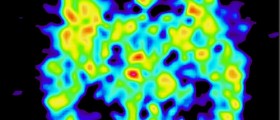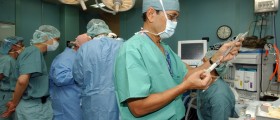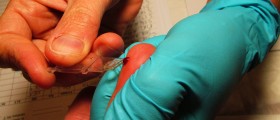
Lumbar puncture (also known as spinal tap) is an invasive procedure which includes insertion of a needle inside the the spinal canal. It is performed to collect samples of cerebrospinal samples which are then further assessed. Lumbar puncture is an excellent diagnostic tool for many different illnesses. Furthermore, lumbar puncture is sometimes employed for therapeutic purpose. Certainly, there are some risks associated with the procedure. However, most of complications are not severe and the most serious ones do not occur so frequently.
How is It Performed?
Patients lie down in a lateral position with their neck and knees bent in full flexion. Sometimes they may sit with the head and shoulder bent forward, towards the knees. In order to reach cerebrospinal fluid the doctor inserts the needle deep between the third and the fourth lumbar vertebrae. The entire procedure is performed under sterile conditions.
Lumbar Puncture - Purpose
The procedure is the cornerstone for confirming certain neurological conditions such as meningitis. After collecting samples of cerebrospinal fluid, its pressure is measured with a column manometer and it is further examined microscopically. It is essential to evaluate the concentration of certain substances (such as glucose) and to identify microorganisms responsible for the infection. The presence of blood and elevated number of white blood cells is also of major diagnostic importance.
Apart from meningitis, lumbar puncture is also great procedure for confirming other conditions like benign intracranial hypertension, subarachnoid hemorrhage as well as different diseases of the brain and spinal cord (e.g. multiple sclerosis, tumors etc.).
The procedure is also quite useful for administration of certain medications. For instance, it allows injecting some drugs (chemotherapeutics, antibiotics etc.) and anesthetics into the cerebrospinal fluid (if necessary).
Finally, if cerebrospinal pressure is rather high it can be easily brought to normal values with this procedure.
Lumbar Puncture Complications
One of the most commonly reported complications of lumbar puncture is headache. It affects approximately 40% of all patients. The pain is located at the base of the skull or it develops in a form of frontal headache. There is no reason for one to worry, because this headache normally resolves within a couple of days. It can be controlled with pain killers or some analgesics.
Cerebrospinal fluid leakage is more complex and much more serious complication. In patients in whom headache persists and does not subside even after several days, doctors may suspect cerebrospinal leakage. If the complication is confirmed, it is easily dealt with epidural blood patch procedure.
Back Pain and Nerve Injuries
Back pain is another potential complication. It affects the lower part of the back, to be more price the site of insertion of the needle.
Unfortunately, certain number of patients ends up with nerve injury of different intensity.
Spinal Cord Injuries
Finally, rare complications of lumbar puncture include trauma/injury to the spinal cord, spinal/epidural bleeding, paraplegia/ paralysis of lower half of the body, spinal hematomas, subarachnoid cysts, cranial neuropathies and seizures. Such complications frequently affect people suffering from certain illnesses such as brain tumors, epidural infections and brain hemorrhage.
- www.nhs.uk/conditions/lumbar-puncture/
- pubmed.ncbi.nlm.nih.gov/9421542/
- Photo courtesy of BruceBlaus by Wikimedia Commons: commons.wikimedia.org/wiki/File:Blausen_0617_LumbarPuncture.png



_f_280x120.jpg)













Your thoughts on this
Loading...